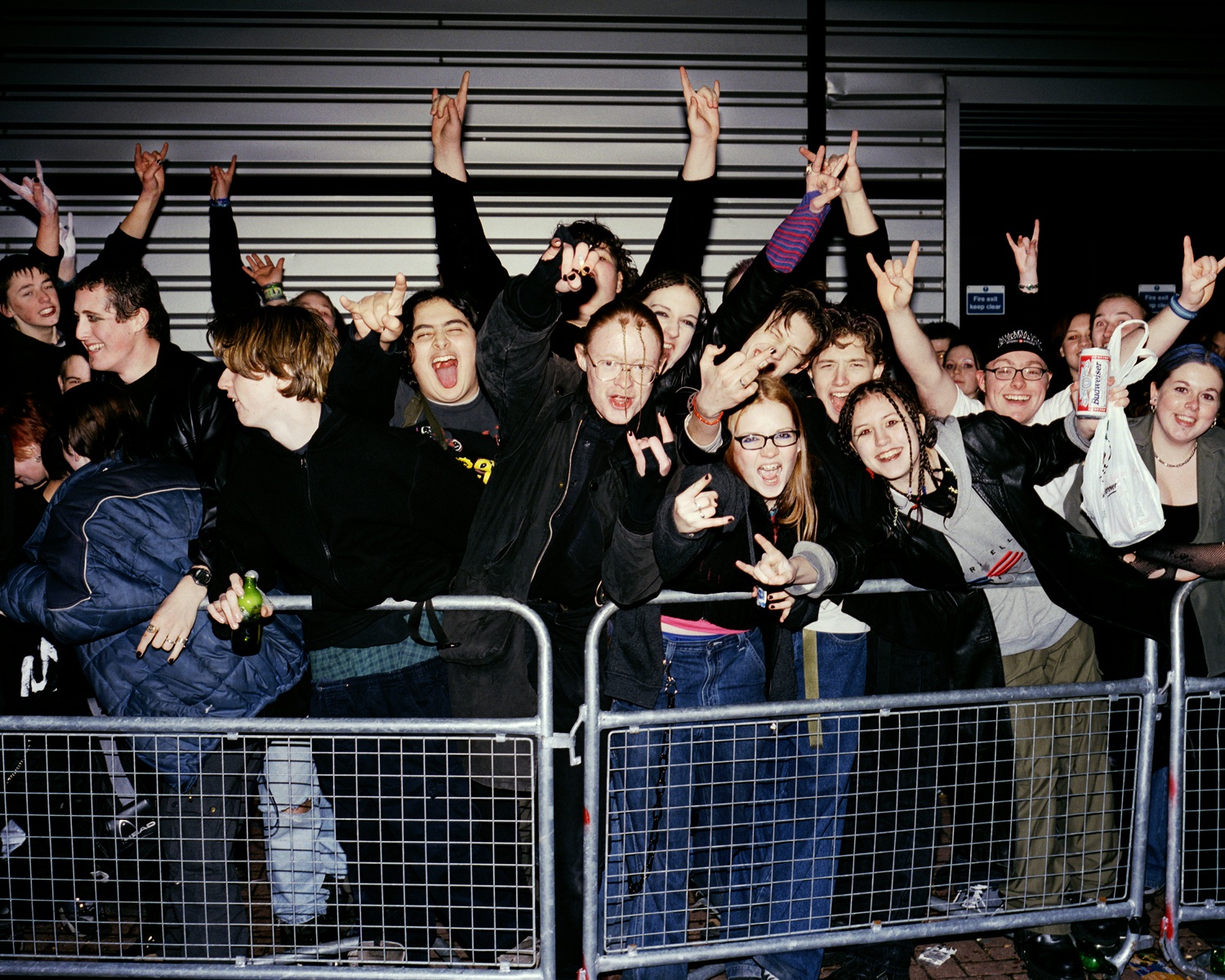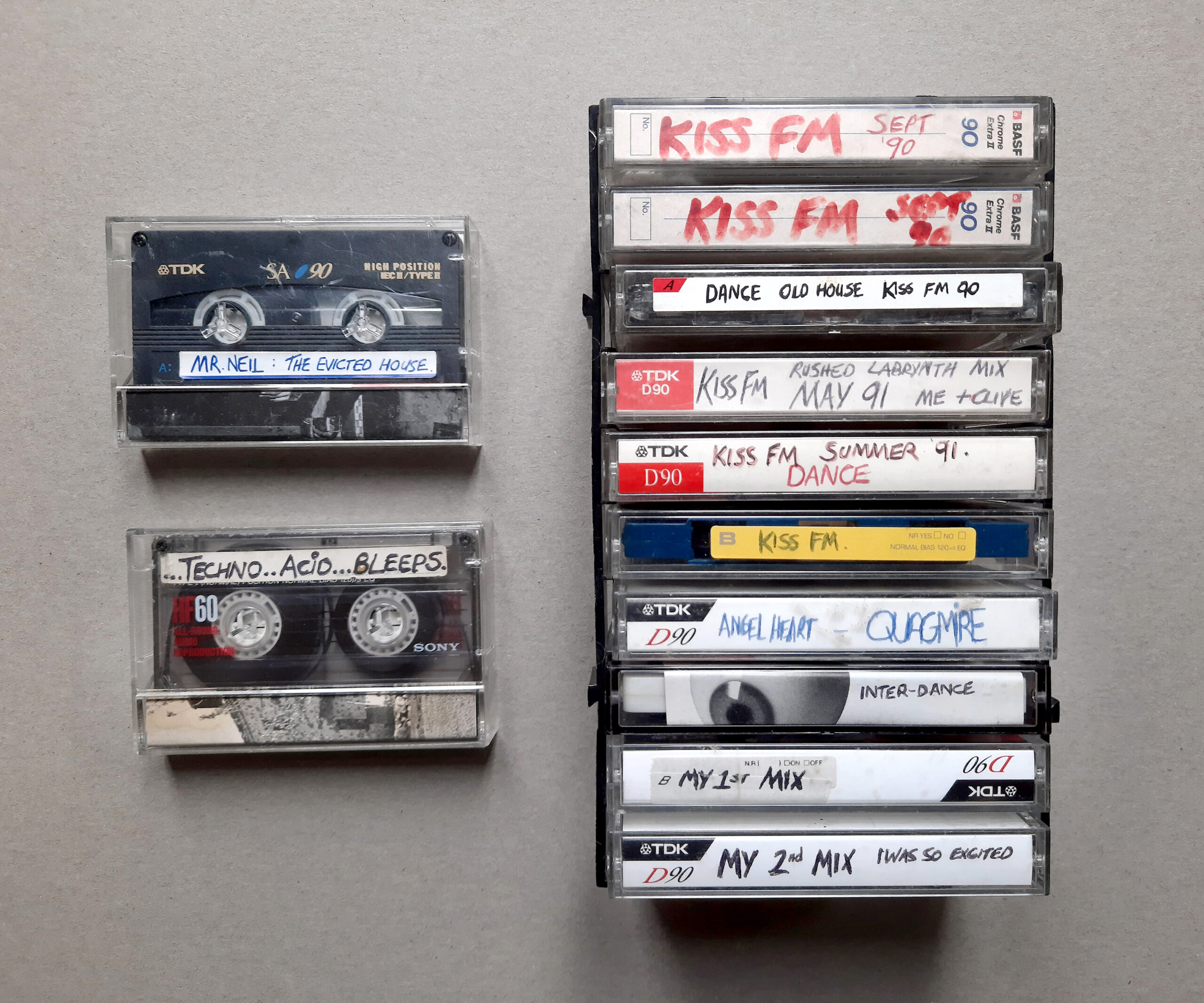

Breaking The Millennium
With Neil Massey
Photographer Neil Massey began his music adventures visiting local punk bands before going on to the late eighties raves. By the Millennium he was working as a photographers and captured the often shocking and always striking fans of the new music, coming over from America and charged media outraged.
Interview by Esta Maffrett | 22.11.22
How did you get into photography?
I started in photography really young. I came to it when I was 15 in my last year of school. Both my parents were Londoners but they moved up to Hampshire to give the kids a greener and cleaner upbringing. So when I was 15 I needed to pass my art exam, my mate Martin’s dad had a darkroom, we could take some photos and then go to his to develop them. I ended up photographing some Banger Racing over Aldershot Racing Track, they called it the demolition derby and there was a figure eight race track that the cars would speed full power over. That was the first assignment I set myself, I learnt photography from there and fell in love with it. Seeing black & white pictures come up in the tray at that age was pretty special and quite powerful. It felt like a privilege to learn a craft at that age. I passed my art exam with a grade 1 and then turned our family shed into a darkroom. I photographed my mates and local punk bands. In 1989 I went to Reading Rock Festival with my friends and begun experimenting with psychedelics, listening to all sorts of bands like The Pogues, Gay Bikers on Acid, The Mission, Butthole Surfers. One night we went off site and found this trendy little wine bar that had an acid house night, that was our little transition into the rave scene.
How important was visual identity in the millennium as a time where the internet was just breaking through but wasn’t quite a dominant force yet?
By the time the Millennium came I was working as a photographer, photographing the things I loved ; youth culture and music scenes. Now, I had a job to do, getting photos to a magazine, but because I had experienced similar in my youth I was able to tap into it really quickly.
In the late 80’s early 90’s it was all baggy, baggy jeans and baggy clothes, the girls and boys were all wearing sort of similar clothes. It looked good but it was practical for being outside and dancing all night. I photographed two gig’s one month apart in early 2001, Eminem then Marilyn Manson, both at the Docklands Arena. Attitude wise the fans were really similar, there was a lot of flipping of the middle finger, it was lairy, it was really young as well like early to mid teens. Attitude wise it was similar but obviously the fashion was different. These artists at that time shared being public enemy number one by the American and English media, scaring the parents when they came over with the Satanic Panic. So I found a really symbiotic kind of attitude and spirit which I really enjoyed. Actually I think it took me right back to being their age and my experience of the alternative scene in the late 80’s.
How did the time of the millennium feel different or new to what had come before?
Well when you’re in something you don’t really analyse it. When I look back at the pictures and I hear music from the early 2000s I kind of realise it was all a bit crazy and everything seemed a bit debauched and out there. You had the artists causing a stir in the media and the lyrics were suggestive and provocative. If you’ve watched Woodstock ‘99 you see how everything felt amped up. Maybe there was some kind of subconscious about the new millennium coming.
I think young people and when you’re in your teens you want to look good. You want to look good for yourself but you also want to look cool in front of your mates, that’s kind of always happened, it’s a rite of passage when finding your tribe and your group, the pack you roll with. It happened before social media but now it’s been amplified, and there’s a self awareness of having to look good and having to perpetually self promote. When I was growing up you had the alternative scene which was almost like one big family of anybody that was a bit out there or a bit odd, it wasn’t so defined. I’d say around the late 90s, early 2000s things got a bit more defined by your specific interests.
"I think young people and when you’re in your teens you want to look good. You want to look good for yourself but you also want to look cool in front of your mates, that’s kind of always happened, it’s a rite of passage when finding your tribe and your group, the pack you roll with."

You were beginning to see and understand the way music and young people moved in cycles?
From the 1990’s to the 2000s magazines played a massive role in sharing ideas, scenes and music - doing what social media does now. In 1990 I read a piece in i-D Magazine about this party island called Koh Phangan in Thailand which was a party island. Soon enough I was there and spent three months travelling around the country and cutting my teeth as a travel photographer and street photographer. I captured Christmas, New Year, and Full Moon Parties but they’ve never been published. I remember maybe one other guy in his early 20s with a professional ish looking camera but that was it. You didn’t even really think about if there were other photographers, there weren’t that many. Before I went away to Thailand in 1990 I was attending the DiY illegal free-parties and field parties in the home counties. I was totally involved in it and didn’t take any pictures, didn’t document it but just experienced it. Part of me wishes there were pictures but on the other hand I had a great time, so it’s good to have good memories as well, it’s not all about pictures.
It was only around the early 2000s that I really realised the importance of documenting life, whether that be straight up documentary photography or street scenes, fashion portraits and fans outside venues and in clubs. Photographing real life I guess is what I'm trying to say. I really understood that around the early 2000s, how important those pictures are later on in a historical context and how they mature like a fine wine. Hopefully becoming interesting for the next generations.
How did you go on to photograph the underground scene in Vietnam and how was it different from the UK?
I moved to Saigon, Vietnam in 2009 and lived there for six years. After a few months of being there I was really searching for the underground scene, trying to figure out what was going on, eventually I found the metal scene. I started going along to these gigs with 50 people going absolutely crazy. It was underground in the sense that in Vietnam at the time the music was a lot of V Pop, super polished and young kiddish, these guys couldn't be more opposite. It got heavier and harder in the time I was photographing, they were playing grindcore, death metal and thrash. There were only about four or five bands all interchanging, falling out and joining each other's band. I loved the brutal energy of the music even though metal was not my thing I loved the spirit of it all. I bought a medium format film camera back from England, shot it on black & white film and processed it all in my bathroom, that became the series called Bloody Chunks. It was the name of a local label that started over there and they took the name from a Cannibal Corpse song called Bloody Chunks.
How has it been rediscovering your archive?
Since 2020 I’ve had some time on my hands and I started to scan my negative archive. I'm still scanning and I've been sharing my work on Instagram as I go along. It’s been really encouraging, especially reaching a new or a younger audience who respond really positively as well as the older generation who were there. It’s great to create a dialogue with the audience, sharing my pictures creates a conversation. As I said back in the 2000s everything was a bit lairy and in your face. My edits from that time reflected that. It’s really nice going back to that work again and editing with a different sensibility. I’ve really enjoyed finding quieter pictures at a crazy gig or club or whatever and seeing something that has a nice story going on but isn’t as obvious, it tells another side of that event.
If you could put one object into the Museum of Youth Culture what would it be and why?
I’m a total hoarder and I love that I've hoarded everything. I've got rave whistles still with fluoro paint on, and random things from gigs / festivals. So, I would give my rave tapes. I’ve got Kiss FM Radio recordings from 90 - 91 just as it was going legal. At the time I was in Hampshire listening to this pirate station with my tape player pressing record and play, quickly pausing if something I didn’t like came on. So it would end up as some crude kind of chopped up mixed tape. I was trying to be a DJ, everybody wanted to be a DJ in the 90s, being in a band wasn’t cool at that point. So this is a hilarious little goldmine capturing the music and spirit of that time.
If you could put one object into the Museum of Youth Culture what would it be and why?
I’m a total hoarder and I love that I've hoarded everything. I've got rave whistles still with fluoro paint on, and random things from gigs / festivals. So, I would give my rave tapes. I’ve got Kiss FM Radio recordings from 90 - 91 just as it was going legal. At the time I was in Hampshire listening to this pirate station with my tape player pressing record and play, quickly pausing if something I didn’t like came on. So it would end up as some crude kind of chopped up mixed tape. I was trying to be a DJ, everybody wanted to be a DJ in the 90s, being in a band wasn’t cool at that point. So this is a hilarious little goldmine capturing the music and spirit of that time.








